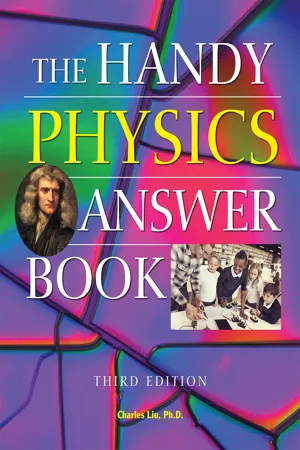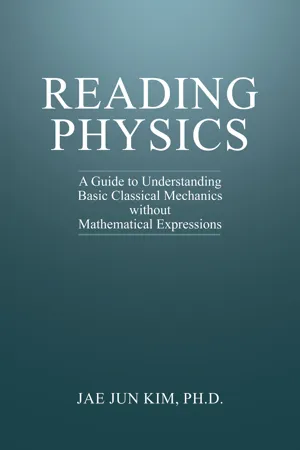Physics
Free Fall and Terminal Velocity
Free fall refers to the motion of an object falling under the sole influence of gravity, with no other forces acting upon it. Terminal velocity is the maximum velocity reached by a falling object when the force of air resistance equals the force of gravity, resulting in a constant velocity. These concepts are fundamental in understanding the motion of objects in free fall.
Written by Perlego with AI-assistance
Related key terms
9 Key excerpts on "Free Fall and Terminal Velocity"
- No longer available |Learn more
MCAT Physics and Math Review 2024-2025
Online + Book
- (Author)
- 2023(Publication Date)
- Kaplan Test Prep(Publisher)
For now, we will assume air resistance to be negligible, meaning that the only force acting on the object would be the gravitational force causing it to fall. Consequently, the object would fall with constant acceleration—the acceleration due to gravity (g = 9.8 m s 2) —and would not reach terminal velocity. This is called free fall. Under these conditions of a free-falling object that has not reached terminal velocity, which are typical for Test Day, we could analyze the fall, using the relevant kinematics equations. Example: A ball is thrown vertically up into the air from a window ledge 30 meters above the ground with an initial velocity of 10 m s. Find the velocity and position of the ball after two seconds. Find the distance and time at which the ball reaches its maximum height above the window ledge. Solution: Remember that velocity and acceleration are vector quantities. For this question, let’s call the ball’s initial position, y 0, zero. If we consider up to be positive, then the initial velocity, v 0, is + 10 m s, and the acceleration, g, is − 9.8 m s 2. Note that g is negative because it’s oriented downward. Velocity after two seconds can be found using Equation 1.18: v = v 0 + a t = + 10 m s + - 9. 8 m s 2 2 s = 10 m s - 19. 6 m s = - 9. 6 m s After two seconds, the position of the ball is found using Equation. 1.19: y = v 0 t + a t 2 2 = (10 m s) (2 s) + (− 9.8 m s 2) (2 s) 2 2 = 20 − 19.6 = 0.4 m (above the ledge) When the ball is at its maximum height, the velocity, which has been decreasing on the way up, is now zero. We can find the maximum height the ball reaches using Equation 1.20: v 2 = v 0 2 + 2 a y 0 2 = (10 m s) 2 + 2 (− 9.8 m s 2) (y) 19.6 y = 100 y ≈ 5 m (actual = 5.1 m) The time at which the ball reaches its maximum height can be found from Equation - eBook - ePub
- Laurie Ann Callihan, David Callihan(Authors)
- 2013(Publication Date)
- Research & Education Association(Publisher)
2 , the velocity will be 32 ft/s (9.8 m/s) after one second. Because the object is accelerating, the velocity after 2 seconds will be 2 s × 32 ft/s/s = 64 ft/s (19.6 m/s). After 10 seconds, the velocity will be 10 s × 32 ft/s/s = 320 ft/s or 98 m/s.Although a falling object will continue to accelerate until it is made to stop (when it hits the ground), air resistance will slow down that acceleration. Air resistance is approximately proportional to the square of the velocity, so as the object falls faster, the air resistance increases until it equals the force of gravity. The point at which these forces are equal is called its terminal velocity. For instance, a falling baseball reaches 94 miles per hour or 42 meters/second; it would remain at that velocity and no longer accelerate. A penny dropped from a high building will accelerate until it reaches around 230 mph.The acceleration of the force of gravity on falling bodies is independent of the mass of the falling object. Therefore, a 15-pound weight would fall at the same rate as a 2-pound weight and would hit the ground at the same time if dropped from the same height. In addition, gravity of the mass of an object is also independent of the velocity of the object parallel to the ground. For example, two bullets are positioned at the same initial height. One is shot from a gun horizontal to the surface. The other bullet is dropped at the exact same time as the bullet is fired from the gun. Both bullets will hit the ground at the exact same time, if no incidental air resistance or friction exists.F = maSince force = mass times acceleration, the universal gravity equation implies that as objects are attracted and get closer together, the force increases and the acceleration between them also increases.CLASSICAL MECHANICSMechanics is the study of things in motion. Classical mechanics involves particles bigger than atoms and slower than light. Newton’s Laws of Motion - eBook - ePub
- A. D. Johnson(Author)
- 2017(Publication Date)
- CRC Press(Publisher)
2 .If a feather and a steel ball are dropped from the same height at the same time, the steel ball will hit the ground first. Both objects will be attracted towards the ground at the same rate; however, air resistance on the feather prevents it from falling towards the earth with the same acceleration. If the same experiment were to be performed on the moon, where there is negligible atmosphere, both the ball and the feather would reach the surface at the same time.In some instances air resistance may be a significant factor, as in the case of a parachutist, but in many cases the value is so small it may be ignored.The motion of falling bodies can be analysed using equations (2.2) , (2.3) , (2.4) and (2.5) .Example 2.6 A stone is dropped from the parapet of a bridge into the water below. The stone takes 4s to fall from the moment of release to the moment when it hits the water. Estimate the height of the bridge. SolutionThe height of the stone upon release can be found using equation (2.4) :s =v 1t +1 2at 2but v 1 = 0 and a = g = 9.81 m/s2 , sos == 78 .5m9 .81 ×24 2Example 2.7A stone is dropped from a 100 m high tower. Assuming g = 9.81 m/s2 - eBook - ePub
Instant Notes in Sport and Exercise Biomechanics
Second Edition
- Paul Grimshaw, Michael Cole, Adrian Burden, Neil Fowler(Authors)
- 2019(Publication Date)
- Garland Science(Publisher)
from when (and before) it left our hand, gravity was affecting its vertical (upwards) movement). Similarly, it will also have an accumulating negative vertical velocity coming downwards (negative indicating it is moving downwards). If you manage to catch the ball at the exact same height as that at which you released it, you will find that at this point the ball will have the same vertical velocity (ignoring air resistance) as it had when it left your hand (although it will now have a negative sign indicating a downwards movement). Figure B2.3b identifies this in more detail. If the ball is not caught and it is allowed to continue to fall until it hits the ground, it will continue to accelerate at a rate of − 9.81 m/s 2 in this direction. The ball will accelerate at − 9.81 m/s 2 until it is acted upon by an external force such as contact with the ground (the force from the ground acting on the ball) or any other object, or until it reaches “terminal velocity” (where the net forces from gravity and air resistance, when not negligible, are balanced). Now, if we take the same ball and this time throw it with both a vertical velocity (the same as in our previous experiment) and a horizontal velocity (i.e. it would now project into the air at an angle) we could demonstrate exactly the same effect from the force of gravity. Figure B2.4 illustrates this in more detail. The ball will travel to the same height as it did in our experiment where we just threw it vertically (because it has had the same vertical force applied to it), but now because it also has a component of horizontal velocity it will travel in a parabolic flight path (upwards and forwards). If the ball is caught at the same height as it was released we know that it will have the same vertical velocity as when it was released (even though it is now also travelling in a parabolic flight path with added horizontal displacement) - eBook - ePub
Doing Physics with Scientific Notebook
A Problem Solving Approach
- Joseph Gallant(Author)
- 2012(Publication Date)
- Wiley(Publisher)
If the displacement and velocity have the same sign, the object is moving away from the origin. If they have opposite signs, the object is moving toward the origin.Table 2.2 summarizes the sign information for velocity and acceleration for horizontal motion.Table 2.2
If the velocity and the acceleration have the same sign, the object’s speed is increasing. If they have opposite signs, the object is slowing down. For vertical motion, just replace the word “right” with “up” and replace the word “left” with “down” in both tables.Velocity Acceleration Interpretation Positive Positive Moving right, speed increasing Positive Negative Moving right, speed decreasing Negative Positive Moving left, speed decreasing Negative Negative Moving left, speed increasing Free Fall
One famous and important example of constant acceleration motion is the motion of an object under the influence of gravity near the Earth’s surface. This vertical acceleration is a = - g where g = 9.8067 m/ s2 is the acceleration’s magnitude and the minus sign indicates gravity acts down. Because the acceleration due to gravity is approximately constant, all objects fall at the same constant rate.When gravity is the only force acting on an object, we say it is in free fall. As long as the object is not too light or moving too fast, air resistance is negligible and gravity determines its motion. An object is in free fall as soon as it is released, whether it is dropped or thrown, whether it is going up or down.We can apply Eqs. (2.5) to this problem. To distinguish horizontal motion from vertical, let’s rewrite the equations of motion letting y denote vertical position (height). When you change x → y and let a = - g, you have the following four equations.(2.6a)(2.6b)(2.6c)(2.6d)These four equations describe the motion of an object that is dropped or thrown straight up or down under the influence of gravity with negligible air resistance. They relate the object’s height and vertical velocity to the acceleration due to gravity and the time, with up as positive and down as negative. - eBook - ePub
- Charles Liu(Author)
- 2020(Publication Date)
- Visible Ink Press(Publisher)
Now suppose the ball is thrown upward with the same 2.0 m/s speed. Now we have to be very careful with the sign of the velocity. We have chosen the downward direction as positive. So, the initial velocity of the ball is actually –2.0 m/s.The gravitational force acts in the downward direction. By Newton’s Second Law, that means that the ball will slow down at a rate of 9.8 m/s each second. After 0.1 seconds, it would be going –2.0 + 0.98 = –1.02 m/s. After 0.20 seconds, it would be going –2.0 + 1.96 = –0.04 m/s. It is almost at rest! But the gravitational force is still acting on it, so it continues to accelerate downward. After 0.30 seconds, it would be going –2.0 + 2.94 = +0.94 m/s. That is, it would now be moving downward.Intuitively, it would make sense that an apple would fall faster than a light object, like a feather. If you remove any resistance caused, for example, by air, the two objects will reach the ground at the same time when dropped!Does a heavier object fall faster than a lighter object?
The Italian scientist Galileo Galilei famously conducted this experiment four centuries ago. He dropped pairs of objects of different weight and mass—a pressing iron and a wooden ball, for example, and cannonballs of different sizes—from the Leaning Tower of Pisa, and they all took the same amount of time to fall.You can try this experiment yourself: hold a heavy object (like a basketball) in one hand and a lighter object (like a tennis ball) in the other. Hold them at the same height and then let go of them simultaneously. They will hit the ground at the same time!Why do objects of different mass fall at the same rate?
When you drop any object and let it fall to the ground, the force of gravity is the only force acting on it. All objects at the same distance from Earth’s center will feel the same gravitational field strength, no matter how massive they are—so those objects will accelerate at the same rate and thus fall at the same speed. - eBook - ePub
Elementary Differential Equations
Applications, Models, and Computing
- Charles Roberts(Author)
- 2018(Publication Date)
- Chapman and Hall/CRC(Publisher)
∞ .Figure 3.12. A Falling Body.If we assume that the body is falling freely in air instead of in a vacuum, then we must make some assumption regarding the retarding force due to air resistance. Let us assume that the retarding force is proportional to the velocity of the body. Then the initial value problem for the velocity becomesd v / d t = g - c v ; v, where( 0 )=v 0c > 0is the constant of proportionality. Separating variables results inIntegrating, we finddv= d t .g - c v= t + A ,- lnc| g - c v |where A is an arbitrary constant. Multiplying by- cand exponentiating, we get| g - c v |=e=- c ( t + A )e- c Ae= B- c te- c twhere B is an arbitrary positive constant. By letting B be an arbitrary constant—positive, negative, or zero—we can remove the absolute value appearing in this equation. Whent = 0,v =, sov 0B = g - cv 0 - eBook - ePub
Reading Physics
A Guide to Understanding Basic Classical Mechanics without Mathematical Expressions
- Jae J. Kim(Author)
- 2023(Publication Date)
- Universal Publishers(Publisher)
Figure 10.1: Imagine that we have an object and someone holds it at a distance with respect to the surface of the Earth. The object is light gray in color, and Earth is gray, and the thin line represents the line perpendicular to the radius of Earth. The object is released at a distance, and it is going to be pulled by the gravitational interaction with Earth. This is what we understand in most cases as a “freely falling” motion in the introduction to classical mechanics. Furthermore, the velocity, which is represented by the arrows in gray, grows with the gravitational acceleration.Remember: what we studied in this lesson is somewhat related to the dynamics part. We are not dealing with a case where we have a single object in the system that we focus on, but we have Earth in the system as an additional entity instead, so we do deal with two objects in a system; thus, it is about dynamics and not entirely about kinematics. We did not study why the size of the acceleration is such and such, but we just take it as fact and focus on how the velocity and the position equations can be revised to accommodate the presence of Earth and how they are related to what we are going to study in the projectile motion.Problems:Day 11 Projectile motion You throw an object in the air, and it is going to fall to the ground. How would you describe the motion in terms of all the quantities that we have studied so far?You hold a coin. You keep the distance between the coin and the floor at 100 cm and then release the coin. Calculate the velocity associated with the coin in the vertical direction just before it is going to hit the floor. Assume that we do not worry about any other objects being present but the coin and Earth.You hold a coin. You keep the distance between the coin and the floor at 1 mile and then release it. Calculate the change of velocity associated with the coin in the vertical direction per second. How large is it, and why is that? - eBook - ePub
- George P. Sutton, Oscar Biblarz(Authors)
- 2016(Publication Date)
- Wiley(Publisher)
The results are The unpowered part of the trajectory reaches zero vertical velocity at its zenith. The height gained in unpowered free flight may be obtained by equating the vertical kinetic energy at power cutoff to its equivalent potential energy, so that The maximum height or zenith location thus becomes. What remains now is to solve the free‐flight portion of vertical descent. The time for descent from the zenith is sec and the final vertical or impact vertical velocity. The total horizontal range to the zenith is the sum of the powered and free‐flight contributions. During free flight, the horizontal velocity remains unchanged at 70.6 ft/sec because there are no accelerations (i.e., no drag, wind, or gravity component). We now need to find the free‐flight time from burnout to the zenith, which is. The total free‐flight time becomes. Now, the horizontal or total range becomes. The impact angle would be around 79°. If drag had been included, solving this problem would have required information on the drag coefficient (C D) and a numerical solution using Eq. 4–17. All resulting velocities and distances would turn out somewhat lower in value. A set of flight trajectories for sounding rockets is given in Ref. 4–3. 4.4 SPACE FLIGHT Newton's law of gravitation defines the gravitational attraction force F g between two bodies in space as: 4–24 Here G is the universal gravity constant (), m 1 and m 2 are the masses of the two attracting bodies (such as the Earth and the moon, or the Earth and a spacecraft, or the sun and a planet), and R is the distance between their centers of mass. The Earth's gravitational constant μ is the product of Newton's universal constant G and the mass of the Earth,. It is. Rockets offer a means for escaping the Earth's pull for lunar and interplanetary travel, for escaping our solar system, and for launching stationary or moving platforms in space
Index pages curate the most relevant extracts from our library of academic textbooks. They’ve been created using an in-house natural language model (NLM), each adding context and meaning to key research topics.








